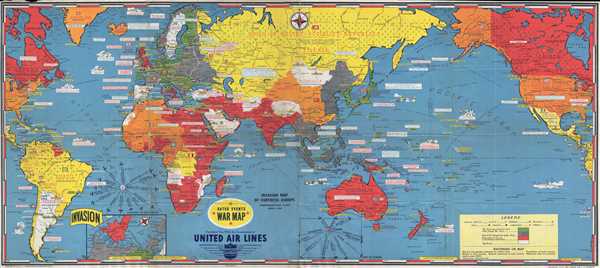This item has been sold, but you can get on the Waitlist to be notified if another example becomes available, or purchase a digital scan.
1944 Turner World Map During World War II
DatedWarMap-turner-1944
Title
1944 (dated 1942) 17 x 38.5 in (43.18 x 97.79 cm) 1 : 32000000
Description
Myriad small boxes of text are placed throughout the map, each one bearing a bit of information about the progress of the war. Some recount Allied defeats, such as the fall of France. Others commemorate Allied victories, such as the invasion of France or the back and forth of the North African campaign. Diplomatic benchmarks are included as well, such as the Casablanca conference, the signing of the Atlantic Charter between Roosevelt and Churchill, or the Lend-Lease Act. The date that a certain country joined the Allied cause is also reported for numerous countries around the world.
An inset map along the bottom border details the reality of the Allied invasion of France. Distances between different points along the English coast and the French coast are given. Countries that remained occupied by the Nazis are labeled as such, Nazi Occupied France and Nazi Occupied Denmark are two good examples. A big yellow arrow proclaims the INVASION in block lettering. Just above the inset map is a sort of inverted compass, entitled Closing In On Berlin, detailing the distances aerial bombing missions had to travel from European capitals to reach Berlin. The same sort of inverted compass is included along the bottom border giving distances from various locations around the Pacific theater to Tokyo.
World capitals are labeled throughout the map, along with numerous other cities in countries the world over. The flags of the nations of the world are also depicted, including the American flag, the Union Jack, and the flags of Imperial Japan and Nazi Germany. Ships, some of which are illustrated with the camouflage paint schemes that were popular during World War I and World War II, are depicted throughout the world’s oceans. A legend explaining the different colors and symbols employed on the map is located in the lower right corner. A title stating that this map was printed to commemorate D-Day, as an Invasion Map of Fortress Europe, is included, along with a decal stating that this particular example of this map was furnished compliments of United Air Lines.
This map was drawn by Stanley Francis Turner and published by C. C. Peterson. This is the 18th edition of the Dated War Map. We are aware of 25 different editions, although there could be more. Each example that we have seen also was furnished by a different company, thus giving each example a different look. This map is very attractive and covered with incredible information. It truly is a piece of history.
Cartographer
Stanley Francis Turner (1883 – 1953) was a visual artist and painter based in Toronto, Canada. Turner was born in Aylesbury, England. He studied art in London at the South Kensington School before migrating to Canada in 1903, where he studied at Ontario College of Art under George Reid and J. W. Beatty. Turner is best known as a painter and designer capable of working in a variety of mediums. During World War II, Turner took a contract with the Globe and Mail to illustrate pictorial maps of war events. Turner may have maintained the rights to his war maps, as he also seems to have had a contract with the advertiser and publisher, C.C. Peterson, also of Toronto, to publish and distribute his maps in the United States. Turner's maps are information dense and designed to illustrate the events of the war in an easily digestible pictorial format. Turner experimented with different ways of working with the cartographic ranging from simple Mercator projections to more contemporary equal-area projections. In 1930, Turner was elected an Associate of the Royal Canadian Academy of Arts. He died in Toronto in 1953. More by this mapmaker...

